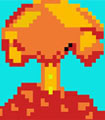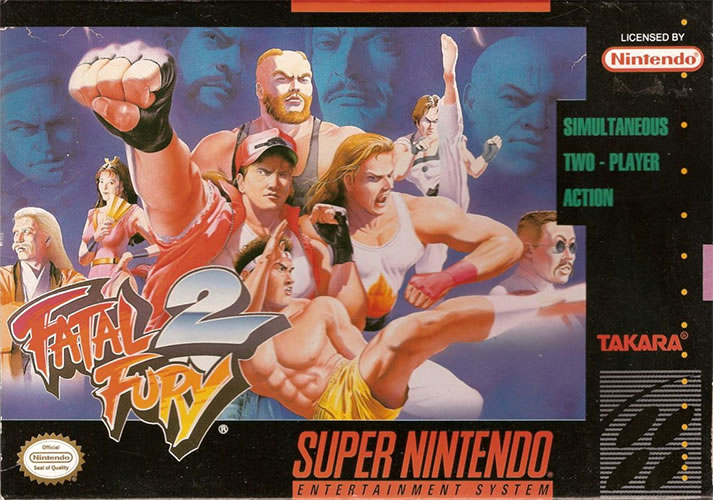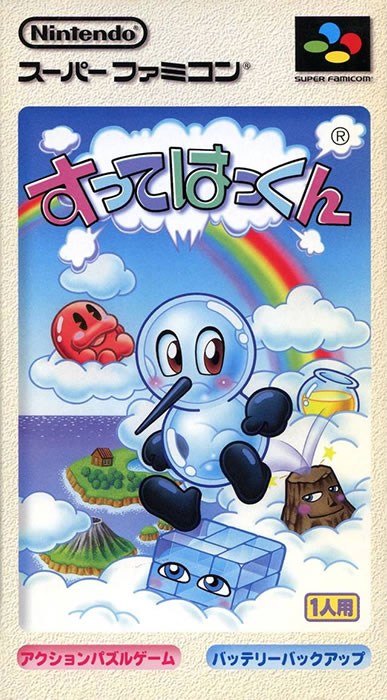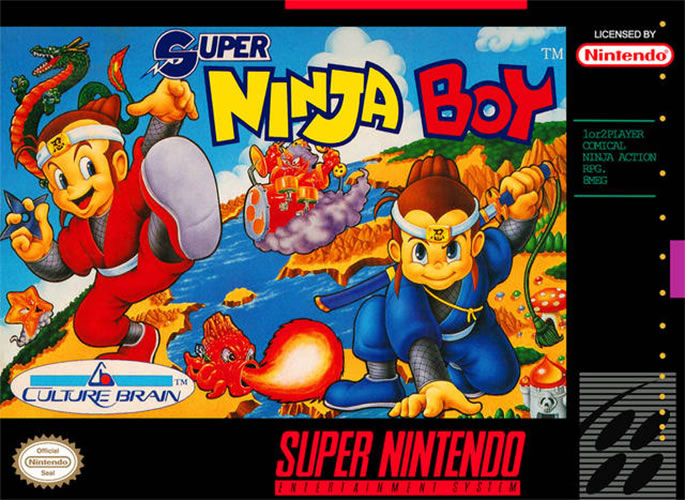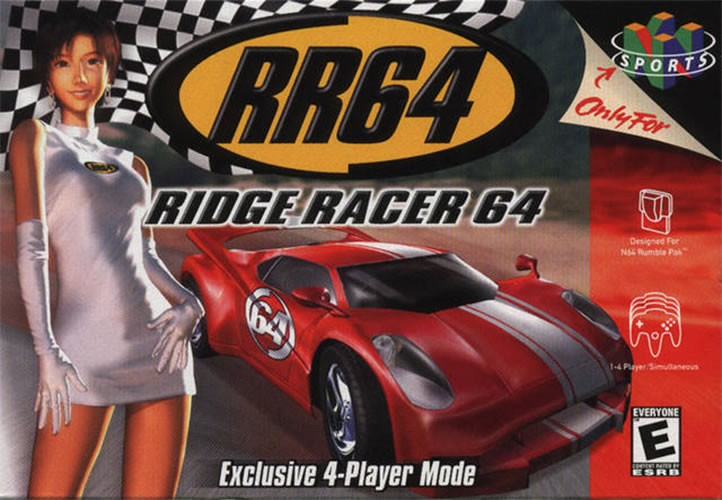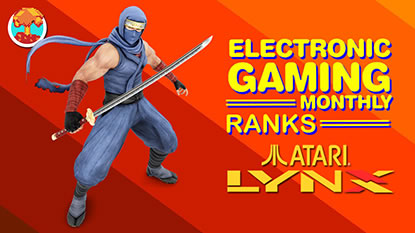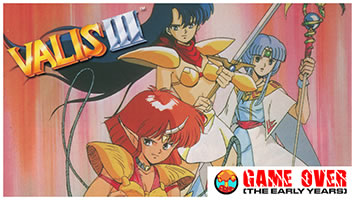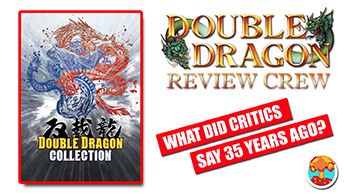- CLASSIC MAGAZINES
- REVIEW CREW
A show recapping what critics thought back
when classic games first came out! - NEXT GENERATION'S BEST & WORST
From the worst 1-star reviews to the best
5-stars can offer, this is Next Generation! - NINTENDO POWER (ARCHIVE)
Experience a variety of shows looking at the
often baffling history of Nintendo Power! - MAGAZINE RETROSPECTIVE
We're looking at the absolutely true history of
some of the most iconic game magazines ever! - SUPER PLAY'S TOP 600
The longest and most ambitious Super NES
countdown on the internet! - THEY SAID WHAT?
Debunking predictions and gossip found
in classic video game magazines! - NEXT GENERATION UNCOVERED
Cyril is back in this spin-off series, featuring the
cover critic review the art of Next Generation! - HARDCORE GAMER MAGAZING (PDF ISSUES)
Download all 36 issues of Hardcore Gamer
Magazine and relive the fun in PDF form!
- REVIEW CREW
- ELECTRONIC GAMING MONTHLY
- ELECTRONIC GAMING MONTHLY RANKS
From Mario to Sonic to Street Fighter, EGM
ranks classic game franchises and consoles! - ELECTRONIC GAMING MONTHLY BEST & WORST
Counting down EGM’s best and worst reviews
going year by year, from 1989 – 2009! - ELECTRONIC GAMING BEST & WORST AWARDS
11-part video series chronicling the ups and
downs of EGM’s Best & Worst Awards!
- ELECTRONIC GAMING MONTHLY RANKS
- GAME HISTORY
- GAME OVER: STORY BREAKDOWNS
Long-running series breaking down game
stories and analyzing their endings! - A BRIEF HISTORY OF GAMING w/ [NAME HERE]
Real history presented in a fun and pithy
format from a variety of game historians! - THE BLACK SHEEP
A series looking back at the black sheep
entries in popular game franchises! - INSTANT EXPERT
Everything you could possibly want to know
about a wide variety of gaming topics! - FREEZE FRAME
When something familiar happens in the games
industry, we're there to take a picture! - I'VE GOT YOUR NUMBER
Learn real video game history through a series
of number-themed episodes, starting at zero! - GREAT MOMENTS IN BAD ACTING
A joyous celebration of some of gaming's
absolute worst voice acting!
- GAME OVER: STORY BREAKDOWNS
- POPULAR SHOWS
- DG NEWS w/ LORNE RISELEY
Newsman Lorne Riseley hosts a regular
series looking at the hottest gaming news! - REVIEW REWIND
Cyril replays a game he reviewed 10+ years
ago to see if he got it right or wrong! - ON-RUNNING FEUDS
Defunct Games' longest-running show, with
editorials, observations and other fun oddities! - DEFUNCT GAMES QUIZ (ARCHIVE)
From online quizzes to game shows, we're
putting your video game knowledge to the test!- QUIZ: ONLINE PASS
Take a weekly quiz to see how well you know
the news and current gaming events! - QUIZ: KNOW THE GAME
One-on-one quiz show where contestants
find out if they actually know classic games! - QUIZ: THE LEADERBOARD
Can you guess the game based on the classic
review? Find out with The Leaderboard!
- QUIZ: ONLINE PASS
- DEFUNCT GAMES VS.
Cyril and the Defunct Games staff isn't afraid
to choose their favorite games and more! - CYRIL READS WORLDS OF POWER
Defunct Games recreates classic game
novelizations through the audio book format!
- DG NEWS w/ LORNE RISELEY
- COMEDY
- GAME EXPECTANCY
How long will your favorite hero live? We crunch
the numbers in this series about dying! - VIDEO GAME ADVICE
Famous game characters answer real personal
advice questions with a humorous slant! - FAKE GAMES: GUERILLA SCRAPBOOK
A long-running series about fake games and
the people who love them (covers included)! - WORST GAME EVER
A contest that attempts to create the worst
video game ever made, complete with covers! - LEVEL 1 STORIES
Literature based on the first stages of some
of your favorite classic video games! - THE COVER CRITIC
One of Defunct Games' earliest shows, Cover
Critic digs up some of the worst box art ever! - COMMERCIAL BREAK
Take a trip through some of the best and
worst video game advertisements of all time! - COMIC BOOK MODS
You've never seen comics like this before.
A curious mix of rewritten video game comics!
- GAME EXPECTANCY
- SERIES ARCHIVE
- NINTENDO SWITCH ONLINE ARCHIVE
A regularly-updated list of every Nintendo
Switch Online release, plus links to review! - PLAYSTATION PLUS CLASSIC ARCHIVE
A comprehensive list of every PlayStation
Plus classic release, including links! - RETRO-BIT PUBLISHING ARCHIVE
A regularly-updated list of every Retro-Bit
game released! - REVIEW MARATHONS w/ ADAM WALLACE
Join critic Adam Wallace as he takes us on a
classic review marathon with different themes!- DEFUNCT GAMES GOLF CLUB
Adam Wallace takes to the links to slice his way
through 72 classic golf game reviews! - 007 IN PIXELS
Adam Wallace takes on the world's greatest spy
as he reviews 15 weeks of James Bond games! - A SALUTE TO VAMPIRES
Adam Wallace is sinking his teeth into a series
covering Castlevania, BloodRayne and more! - CAPCOM'S CURSE
Adam Wallace is celebrating 13 days of Halloween
with a line-up of Capcom's scariest games! - THE FALL OF SUPERMAN
Adam Wallace is a man of steel for playing
some of the absolute worst Superman games! - THE 31 GAMES OF HALLOWEEN
Adam Wallace spends every day of October afraid
as he reviews some of the scariest games ever! - 12 WEEKS OF STAR TREK
Adam Wallace boldly goes where no critic has
gone before in this Star Trek marathon!
- DEFUNCT GAMES GOLF CLUB
- DAYS OF CHRISTMAS (ARCHIVE)
Annual holiday series with themed-episodes
that date all the way back to 2001!- 2015: 30 Ridiculous Retro Rumors
- 2014: 29 Magazines of Christmas
- 2013: 29 Questionable Power-Ups of Christmas
- 2012: 34 Theme Songs of Christmas
- 2011: 32 Game Endings of Christmas
- 2010: 31 Bonus Levels of Christmas
- 2009: 30 Genres of Christmas
- 2008: 29 Controls of Christmas
- 2007: 34 Cliches of Christmas
- 2006: 33 Consoles of Christmas
- 2005: 32 Articles of Christmas
- 2004: 31 Websites of Christmas
- 2003: 29 Issues of Christmas
- 2002: 28 Years of Christmas
- 2001: 33 Days of Christmas
- NINTENDO SWITCH ONLINE ARCHIVE
- REVIEW ARCHIVE
- FULL ARCHIVE
Nintendo Switch Online: 1990s Critics Review Ridge Racer 64, Fatal Fury 2, Super Ninja Boy & More
After three weeks hanging out on the beach, I'm back! And it's not just me returning, but also the Nintendo Switch Online. In just the last week, Nintendo has added four new games to their online service, including Fatal Fury 2, Super Ninja Boy, the Western debut of Sutte Hakkun and, most recently, Ridge Racer 64. That's genuinely great news, but are any of these games actually worth playing? To answer that question, I decided to flip through the pages of Electronic Gaming Monthly, Super Control, Next Generation and more classic magazines to see what the critics said back when these games first came out. I hope you're sitting down, because we're playing a game of catch-up in this super-sized episode of Nintendo Switch Online Review Crew!
When Street Fighter II hit arcades in 1991, it wasn't just another beat ‘em up cabinet, but a sea change for the industry. It led companies big and small to develop their own one-on-one fighters, trying their hardest to capitalize on the craze. Nobody epitomizes this ethos more than SNK, who rushed out the fun, but ultimately flawed Fatal Fury just eight months after Capcom gave us Street Fighter II. One year later, they followed this up with Fatal Fury 2, a vastly improved sequel with more characters to choose from, improved graphics and a tweaked combat system. It was a genuinely great fighter that console gamers couldn't wait to get their hands on. There was just one problem – very few people were going to pay $600 to own a Neo Geo console and another $200 to buy Fatal Fury 2. Those prices made owning the game financially prohibitive. Super NES owners would need to wait about a year-and-a-half before they could buy a scaled-down version at a half-decent price. We already know that the critics loved Fatal Fury 2 in the arcades, but what did they think of this Super NES port? Let's find out.
When it comes to Electronic Gaming Monthly, they loved the game. They gave it an average score of 8.25 out of 10, enough to make it their Game of the Month for May 1994. Sushi-X couldn't wait to rave about it: “One of the better games ported to the Super NES, Fatal Fury 2 is sure to keep all fighting fans busy, including yours truly. The graphics and playability are a great reproduction of the Neo-Geo version. The sound could be a bit better, but the game doesn't suffer from it. To top it off, the boss code allows you to choose the other four characters, giving you even more guys to master. Fighting fans must check it out.!” Giving it a 9, Ed liked it even more: “When I first heard about this game, I was filled with dread. I didn't think Takara would be able to pull this translation off. I was wrong. This is one of the best fighting games around for the Super NES and shouldn't be missed. Only the music suffers a bit. It's a small price to pay for such an awesome game.”
Believe it or not, EGM's score of 8.25 out of 10 is actually the highest score of any English-language magazine at the time. When you look at some of the other magazines that liked it, you saw Total give it a solid score of 78%, while Super Play went one tick higher and gave it a 79%. “Let's face it: Every new beat ‘em up is inevitably (and rightly) compared to Street Fighter II. Fatal Fury 2 falls short of the mark. If you're a hard-line one-on-one combat aficionado, then the next thing you need to know is its place amongst the best in the Dead Dance region. It's quite fun, with a little bit of depth, but it's nowhere near what you should expect.”
Even further down the scale we see SNES Force give this sequel a 68%, while the notoriously generous GamePro couldn't must up anything higher than a 3.5 out of 5. They explained that “the numerous flaws shouldn't turn you off to the Fatal family forever. This game is just a step up from the previous Fatal Fury, but a couple of flights down from a great fighting game like Super Street Fighter II. If you love the Fatal fighters and you want more bang for your brawlin' buck, then hold out and wait for Fatal Fury Special, which contains everything this game doesn't – speed, combos, and great graphics. Until then, scrape up the three bucks and head out to rent this one.”
If you're wondering what magazine gave Fatal Fury 2 the lowest scores, then the answer is Nintendo Power. Giving the fighter a low 3.1 out of 5, they liked the “third dimension of fighting” and the “cool new characters and moves. Die hard fans will eat it up.” However, they complained that “some character animations looked incomplete” and that “some special moves are particularly brutal to control.”
As you can see, the reviews were all over the place. I'm more on the side of Electronic Gaming Monthly, who was impressed by the quality port. It's not the best fighting game on the SNES (or even the best Fatal Fury game), but it's a sequel that laid a lot of the groundwork for better SNK fighters. I say give it a chance on Nintendo Switch Online. Perhaps it will get you in the mood for the upcoming City of the Wolves, coming in February.
Long after the Super NES had given up the ghost in North America, Nintendo was still delivering fun 16-bit games like Sutte Hakkun to their Japanese audience. First released in 1997 as a Satellaview game, this cute little platformer took inspiration from The Lost Vikings and Lemmings to create a non-violent puzzle game where our hero literally injects color into the world using its beak. Adding colors to platforms will make them act in different ways, allowing you to traverse through increasingly complex stages and locate enough shards to find the exit. It's not especially fast-paced and the graphics aren't as stylish as other late-generation Nintendo releases, but there are more than one-hundred stages and lots of variety keeping you glued to the game. Had this been released in the first-half of the system's life, it likely would have done well around the world. Sadly, due to it coming out in 1997, Sutte Hakkun was limited to Japan. That is, until now. After nearly thirty years, this hidden gem is finally available around the world. So give it a play and see how far you can get in Sutte Hakkun.
When Nintendo added Kung-Fu Heroes back in 2019, there were probably a few people who hoped that it would lead to the rest of the sequels being added to the Nintendo Switch Online. Now, six years later, your patience has paid off with the release of Super Ninja Boy, the Super NES sequel to both Little Ninja Brothers and Ninja Boy. Okay, sure, it sucks that we're skipping four installments to get to the 16-bit era, but it's also fun to see Ninja Boy and Chinaland on the Super NES for the first time. In fact, this was only Culture Brain's second 16-bit game, released just after Super Baseball Simulator, which is already on the Nintendo Switch Online. Let's see if the critics liked Super Ninja Boy more than Kung-Fu Heroes.
When it comes to this game, I thought it would make more sense to start at the bottom and work our way up. Why? Because the first thing we need to do is talk about the one outlier, a magazine that went substantially lower than everybody else. That magazine was Super Control, a short-lived UK rag that ran between 1993 and 1994. They not only gave Super Ninja Boy one of the lowest scores of the year, but one of the lowest scores we've ever seen – 11%. “Oh dear, anyone for a shite sandwich without the bread? Super Ninja Boy takes poor quality into another dimension, delving into the depths of the worst-smelling game of all time ... Home Alone. At first, I thought Super Ninja Boy looked a bit like the Final Fantasy games, which I quite enjoyed. But, Culture Brain has proved it can release yet another turkey with this totally unplayable RPG/action combo. Don't bother wasting 50 pounds on this game, I recommend you have a day out on the Isle of Wight instant.”
Now that we're done with Super Control, the next lowest score is from Video Games & Computer Entertainment, which takes us from 11% all the way up to a 5 out of 10. Clayton Walnum argued that “if Super Ninja Boy has a weakness, it's the poor job done on the translation of the game's text from the original Japanese to English. Sometimes the dialogue between you and other characters makes no sense and contains misspellings. Awkward grammar, too, abounds, yielding such lines as, “I got excited at him.” There really is little excuse for such poor translation in a product that the public is expected to play $50 or more for. All in all, though, Super Ninja Boy is a reasonably good action/role-playing game that, while it doesn't exactly break new ground, does combine the standard elements of other game genres to come up with something a little off the beat track.”
As we continue to climb the scale, you'll see that some critics actually enjoyed the game, giving it solid scores in the 70% range. Play Time, for example, went with a 72%, while Computer & Video Games had the highest score with a 78%. “After several hours of playing, Super Ninja Boy still reminds me of the old Ys adventures; the viewpoint is the same, the basic idea is the same and the same lame attempt at humour has been made! This is basically a wander-around-and-talk-to-people-in-the-hopes-of-finding-clues game, but a pretty good one at that. The clues are all pretty simple and the logic in the puzzles is easy to crack. The sound isn't really much cop, but that's a fairly inconsequential point in an adventure game. All in all, a pretty fair RPG, if you like that sort of thing.”
Look, I'm not going to try to convince you that Super Ninja Boy is one of the best hidden gems on the Super NES, but it does have its special charm and is nowhere near as bad as Super Control would have you believe. With an average of just 53%, this is an example of one outlier really bringing the score down.
When you hear the name Ridge Racer, you probably picture the PlayStation. While it's certainly true that Namco's arcade racer has appeared on a lot of PlayStation consoles, it hasn't been afraid to cross the line and appear on systems as diverse as the Xbox 360 and Nintendo 3DS. The first time this happened was all the way back in 2000 with the release of Ridge Racer 64, a port that not only featured tracks from both Ridge Racer and Ridge Racer Revolution, but also a handful of new desert levels called “Renegade” that were exclusive to the Nintendo 64. As we dig into the reviews, it will be interesting to see how the critics react to this game in a world where games like Rage Racer and Ridge Racer Type 4 already exist.
As I often like to do, let's start with Electronic Gaming Monthly, who largely enjoyed the game, giving it an average score of 8 out of 10. Dean gave it the magazine's lowest score, a 7.5, arguing that “for the most part, Nintendo did a good job of condensing Revolution, Ridge Racer and several new features into a neat N64 package. Personally, I'm not a fan of the trademark Ridge Racer handling. The drifting is so unnatural and forced it ruined the game for me. But if you're a fan, you'll like what Ridge Racer 64 has to offer. Don't count on four-player being too fun though, it's slow. Also, when using the chase cam the cars appear to vibrate on the road ... weird.” John, on the other hand, gave the game the magazine's highest score, an 8.5: “It took me a long time to get back into the Ridge Racer ‘wafty' control style, but after a day or so of adjustment, I really got into this. I'm in two minds as to whether it's actually the ‘best' racer for the N64 ... but it's pretty damn close. It doesn't look quite as nice as the PlayStation games, but it's fast, it offers a huge variety of cars and tracks – and it'll keep you going a lot longer than most similar titles on the system.”
As it turns out, EGM's 8 out of 10 was right in line with the bottom half of the review scores. Nintendo Power technically had the lowest, with a 7.9 out of 10, while Computer & Video Games went one tick higher with a 4 out of 5. That's the exact same score we saw from Next Generation, who was quick to note the game's problems: “Computer-controlled cars tend to cheat horribly, jumping in front and knocking into you faster than should be possible, and at times the collision models are a bit off. However, the overall speed and action of the game, along with the variation of drive and feel of the different cars, makes for a terrific racing experience. As racers go, it's easily among the best for N64, and well worth it even for non-racing fans.”
Turning to the more positive reviews, we saw GamePro give Ridge Racer 64 an impressive 4.5 out of 5, which is right in line with Australian magazine Hyper, who gave it a 90%. “Put the incredible, white knuckle speed alongside the classic track design, and the best arcade power slide mechanics we could hope for, and you've got yourself a winner. Finally, an arcade racing game N64 owners can be proud of! And as always, we had to wait for an in-house Nintendo production team to do it. Start hassling your local game shop for RR64 now!”
If you want even higher scores, then check out Game Fan, who gave the racer a 91%. That's the same score you saw out of N64 magazine in the UK. However, the highest score for Ridge Racer 64 came from Incite Video Gaming, which went all the way up to a perfect 5 out of 5. They proclaimed that “the greatest Nintendo racing game ever has arrived. California Speed? No, Ridge Racer 64? Yes.”
Geez, what did San Francisco Rush do to Incite? Sounds like there's some drama bubbling under the surface. Either way, Ridge Racer 64 was a hit with the critics, though there were a number of complaints levied against the game. It managed to average an impressive 87%, which definitely makes it one of the best-reviewed racing games on the Nintendo 64.
| Publication | Scores |
|---|---|
| Electronic Gaming Monthly | 8.25/10 |
| Super Play | 79% |
| Total | 78% |
| GamePro | 3.5/5 |
| SNES Force | 68% |
| Nintendo Power | 3.1/5 |
| AVERAGE SCORE | 73% |
When it comes to Electronic Gaming Monthly, they loved the game. They gave it an average score of 8.25 out of 10, enough to make it their Game of the Month for May 1994. Sushi-X couldn't wait to rave about it: “One of the better games ported to the Super NES, Fatal Fury 2 is sure to keep all fighting fans busy, including yours truly. The graphics and playability are a great reproduction of the Neo-Geo version. The sound could be a bit better, but the game doesn't suffer from it. To top it off, the boss code allows you to choose the other four characters, giving you even more guys to master. Fighting fans must check it out.!” Giving it a 9, Ed liked it even more: “When I first heard about this game, I was filled with dread. I didn't think Takara would be able to pull this translation off. I was wrong. This is one of the best fighting games around for the Super NES and shouldn't be missed. Only the music suffers a bit. It's a small price to pay for such an awesome game.”
Believe it or not, EGM's score of 8.25 out of 10 is actually the highest score of any English-language magazine at the time. When you look at some of the other magazines that liked it, you saw Total give it a solid score of 78%, while Super Play went one tick higher and gave it a 79%. “Let's face it: Every new beat ‘em up is inevitably (and rightly) compared to Street Fighter II. Fatal Fury 2 falls short of the mark. If you're a hard-line one-on-one combat aficionado, then the next thing you need to know is its place amongst the best in the Dead Dance region. It's quite fun, with a little bit of depth, but it's nowhere near what you should expect.”
Even further down the scale we see SNES Force give this sequel a 68%, while the notoriously generous GamePro couldn't must up anything higher than a 3.5 out of 5. They explained that “the numerous flaws shouldn't turn you off to the Fatal family forever. This game is just a step up from the previous Fatal Fury, but a couple of flights down from a great fighting game like Super Street Fighter II. If you love the Fatal fighters and you want more bang for your brawlin' buck, then hold out and wait for Fatal Fury Special, which contains everything this game doesn't – speed, combos, and great graphics. Until then, scrape up the three bucks and head out to rent this one.”
If you're wondering what magazine gave Fatal Fury 2 the lowest scores, then the answer is Nintendo Power. Giving the fighter a low 3.1 out of 5, they liked the “third dimension of fighting” and the “cool new characters and moves. Die hard fans will eat it up.” However, they complained that “some character animations looked incomplete” and that “some special moves are particularly brutal to control.”
As you can see, the reviews were all over the place. I'm more on the side of Electronic Gaming Monthly, who was impressed by the quality port. It's not the best fighting game on the SNES (or even the best Fatal Fury game), but it's a sequel that laid a lot of the groundwork for better SNK fighters. I say give it a chance on Nintendo Switch Online. Perhaps it will get you in the mood for the upcoming City of the Wolves, coming in February.
Long after the Super NES had given up the ghost in North America, Nintendo was still delivering fun 16-bit games like Sutte Hakkun to their Japanese audience. First released in 1997 as a Satellaview game, this cute little platformer took inspiration from The Lost Vikings and Lemmings to create a non-violent puzzle game where our hero literally injects color into the world using its beak. Adding colors to platforms will make them act in different ways, allowing you to traverse through increasingly complex stages and locate enough shards to find the exit. It's not especially fast-paced and the graphics aren't as stylish as other late-generation Nintendo releases, but there are more than one-hundred stages and lots of variety keeping you glued to the game. Had this been released in the first-half of the system's life, it likely would have done well around the world. Sadly, due to it coming out in 1997, Sutte Hakkun was limited to Japan. That is, until now. After nearly thirty years, this hidden gem is finally available around the world. So give it a play and see how far you can get in Sutte Hakkun.
| Publication | Scores |
|---|---|
| Computer & Video Games | 78% |
| Play Time | 72% |
| Video Games & Computer Entertainment | 5/10 |
| Super Control | 11% |
| AVERAGE SCORE | 53% |
When it comes to this game, I thought it would make more sense to start at the bottom and work our way up. Why? Because the first thing we need to do is talk about the one outlier, a magazine that went substantially lower than everybody else. That magazine was Super Control, a short-lived UK rag that ran between 1993 and 1994. They not only gave Super Ninja Boy one of the lowest scores of the year, but one of the lowest scores we've ever seen – 11%. “Oh dear, anyone for a shite sandwich without the bread? Super Ninja Boy takes poor quality into another dimension, delving into the depths of the worst-smelling game of all time ... Home Alone. At first, I thought Super Ninja Boy looked a bit like the Final Fantasy games, which I quite enjoyed. But, Culture Brain has proved it can release yet another turkey with this totally unplayable RPG/action combo. Don't bother wasting 50 pounds on this game, I recommend you have a day out on the Isle of Wight instant.”
Now that we're done with Super Control, the next lowest score is from Video Games & Computer Entertainment, which takes us from 11% all the way up to a 5 out of 10. Clayton Walnum argued that “if Super Ninja Boy has a weakness, it's the poor job done on the translation of the game's text from the original Japanese to English. Sometimes the dialogue between you and other characters makes no sense and contains misspellings. Awkward grammar, too, abounds, yielding such lines as, “I got excited at him.” There really is little excuse for such poor translation in a product that the public is expected to play $50 or more for. All in all, though, Super Ninja Boy is a reasonably good action/role-playing game that, while it doesn't exactly break new ground, does combine the standard elements of other game genres to come up with something a little off the beat track.”
As we continue to climb the scale, you'll see that some critics actually enjoyed the game, giving it solid scores in the 70% range. Play Time, for example, went with a 72%, while Computer & Video Games had the highest score with a 78%. “After several hours of playing, Super Ninja Boy still reminds me of the old Ys adventures; the viewpoint is the same, the basic idea is the same and the same lame attempt at humour has been made! This is basically a wander-around-and-talk-to-people-in-the-hopes-of-finding-clues game, but a pretty good one at that. The clues are all pretty simple and the logic in the puzzles is easy to crack. The sound isn't really much cop, but that's a fairly inconsequential point in an adventure game. All in all, a pretty fair RPG, if you like that sort of thing.”
Look, I'm not going to try to convince you that Super Ninja Boy is one of the best hidden gems on the Super NES, but it does have its special charm and is nowhere near as bad as Super Control would have you believe. With an average of just 53%, this is an example of one outlier really bringing the score down.
| Publication | Scores |
|---|---|
| Incite | 5/5 |
| Game Fan | 91% |
| N64 Magazine | 91% |
| Hyper | 90% |
| GamePro | 4.5/5 |
| Electronic Gaming Monthly | 8/10 |
| Next Generation | 4/5 |
| Computer & Video Games | 4/5 |
| Nintendo Power | 7.9/10 |
| AVERAGE SCORE | 87% |
As I often like to do, let's start with Electronic Gaming Monthly, who largely enjoyed the game, giving it an average score of 8 out of 10. Dean gave it the magazine's lowest score, a 7.5, arguing that “for the most part, Nintendo did a good job of condensing Revolution, Ridge Racer and several new features into a neat N64 package. Personally, I'm not a fan of the trademark Ridge Racer handling. The drifting is so unnatural and forced it ruined the game for me. But if you're a fan, you'll like what Ridge Racer 64 has to offer. Don't count on four-player being too fun though, it's slow. Also, when using the chase cam the cars appear to vibrate on the road ... weird.” John, on the other hand, gave the game the magazine's highest score, an 8.5: “It took me a long time to get back into the Ridge Racer ‘wafty' control style, but after a day or so of adjustment, I really got into this. I'm in two minds as to whether it's actually the ‘best' racer for the N64 ... but it's pretty damn close. It doesn't look quite as nice as the PlayStation games, but it's fast, it offers a huge variety of cars and tracks – and it'll keep you going a lot longer than most similar titles on the system.”
As it turns out, EGM's 8 out of 10 was right in line with the bottom half of the review scores. Nintendo Power technically had the lowest, with a 7.9 out of 10, while Computer & Video Games went one tick higher with a 4 out of 5. That's the exact same score we saw from Next Generation, who was quick to note the game's problems: “Computer-controlled cars tend to cheat horribly, jumping in front and knocking into you faster than should be possible, and at times the collision models are a bit off. However, the overall speed and action of the game, along with the variation of drive and feel of the different cars, makes for a terrific racing experience. As racers go, it's easily among the best for N64, and well worth it even for non-racing fans.”
Turning to the more positive reviews, we saw GamePro give Ridge Racer 64 an impressive 4.5 out of 5, which is right in line with Australian magazine Hyper, who gave it a 90%. “Put the incredible, white knuckle speed alongside the classic track design, and the best arcade power slide mechanics we could hope for, and you've got yourself a winner. Finally, an arcade racing game N64 owners can be proud of! And as always, we had to wait for an in-house Nintendo production team to do it. Start hassling your local game shop for RR64 now!”
If you want even higher scores, then check out Game Fan, who gave the racer a 91%. That's the same score you saw out of N64 magazine in the UK. However, the highest score for Ridge Racer 64 came from Incite Video Gaming, which went all the way up to a perfect 5 out of 5. They proclaimed that “the greatest Nintendo racing game ever has arrived. California Speed? No, Ridge Racer 64? Yes.”
Geez, what did San Francisco Rush do to Incite? Sounds like there's some drama bubbling under the surface. Either way, Ridge Racer 64 was a hit with the critics, though there were a number of complaints levied against the game. It managed to average an impressive 87%, which definitely makes it one of the best-reviewed racing games on the Nintendo 64.
HOME |
CONTACT |
NOW HIRING |
WHAT IS DEFUNCT GAMES? |
NINTENDO SWITCH ONLINE |
RETRO-BIT PUBLISHING
Retro-Bit |
Switch Planet |
The Halcyon Show |
Same Name, Different Game |
Dragnix |
Press the Buttons
Game Zone Online | Hardcore Gamer | The Dreamcast Junkyard | Video Game Blogger
Dr Strife | Games For Lunch | Mondo Cool Cast | Boxed Pixels | Sega CD Universe | Gaming Trend
Game Zone Online | Hardcore Gamer | The Dreamcast Junkyard | Video Game Blogger
Dr Strife | Games For Lunch | Mondo Cool Cast | Boxed Pixels | Sega CD Universe | Gaming Trend
Copyright © 2001-2025 Defunct Games
All rights reserved. All trademarks are properties of their respective owners.
All rights reserved. All trademarks are properties of their respective owners.






